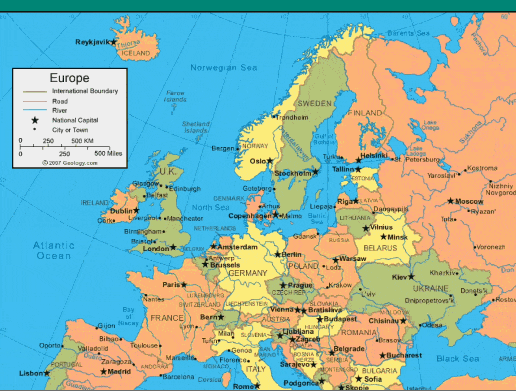我尝试创建一个应用程序,用户可以在其中拖动和缩放ImageView。但是我在以下代码中遇到了问题。
当scaleFactor不为1且第二个手指按下时,它会被稍微移动到其他地方。我不知道这个位移来自哪里...
以下是完整的类:
我尝试了很多方法,但无法使其正常工作。 更新: 以下是如何初始化RamaView实例的方法:
主活动的onCreate:
当scaleFactor不为1且第二个手指按下时,它会被稍微移动到其他地方。我不知道这个位移来自哪里...
以下是完整的类:
package me.miutaltbati.ramaview;
import android.content.Context;
import android.graphics.Bitmap;
import android.graphics.BitmapFactory;
import android.graphics.Canvas;
import android.graphics.Color;
import android.graphics.Matrix;
import android.graphics.Paint;
import android.graphics.PointF;
import android.util.AttributeSet;
import android.view.MotionEvent;
import android.view.ScaleGestureDetector;
import android.widget.ImageView;
import static android.view.MotionEvent.INVALID_POINTER_ID;
public class RamaView extends ImageView {
private Context context;
private Matrix matrix = new Matrix();
private Matrix translateMatrix = new Matrix();
private Matrix scaleMatrix = new Matrix();
// Properties coming from outside:
private int drawableLayoutId;
private int width;
private int height;
private static float MIN_ZOOM = 0.33333F;
private static float MAX_ZOOM = 5F;
private PointF mLastTouch = new PointF(0, 0);
private PointF mLastFocus = new PointF(0, 0);
private PointF mLastPivot = new PointF(0, 0);
private float mPosX = 0F;
private float mPosY = 0F;
public float scaleFactor = 1F;
private int mActivePointerId = INVALID_POINTER_ID;
private Paint paint;
private Bitmap bitmapLayout;
private OnFactorChangedListener mListener;
private ScaleGestureDetector mScaleDetector;
public RamaView(Context context) {
super(context);
initializeInConstructor(context);
}
public RamaView(Context context, @android.support.annotation.Nullable AttributeSet attrs) {
super(context, attrs);
initializeInConstructor(context);
}
public RamaView(Context context, @android.support.annotation.Nullable AttributeSet attrs, int defStyleAttr) {
super(context, attrs, defStyleAttr);
initializeInConstructor(context);
}
public void initializeInConstructor(Context context) {
this.context = context;
paint = new Paint();
mScaleDetector = new ScaleGestureDetector(context, new ScaleListener());
mScaleDetector.setQuickScaleEnabled(false);
setScaleType(ScaleType.MATRIX);
}
public Bitmap decodeSampledBitmap() {
// First decode with inJustDecodeBounds=true to check dimensions
final BitmapFactory.Options options = new BitmapFactory.Options();
options.inMutable = true;
options.inJustDecodeBounds = true;
BitmapFactory.decodeResource(getResources(), drawableLayoutId, options);
// Calculate inSampleSize
options.inSampleSize = Util.calculateInSampleSize(options, width, height); // e.g.: 4, 8
// Decode bitmap with inSampleSize set
options.inJustDecodeBounds = false;
return BitmapFactory.decodeResource(getResources(), drawableLayoutId, options);
}
public void setDrawable(int drawableId) {
drawableLayoutId = drawableId;
}
public void setSize(int width, int height) {
this.width = width;
this.height = height;
bitmapLayout = decodeSampledBitmap();
}
@Override
public boolean onTouchEvent(MotionEvent event) {
mScaleDetector.onTouchEvent(event);
int action = event.getActionMasked();
switch (action) {
case MotionEvent.ACTION_DOWN: {
int pointerIndex = event.getActionIndex();
float x = event.getX(pointerIndex);
float y = event.getY(pointerIndex);
// Remember where we started (for dragging)
mLastTouch = new PointF(x, y);
// Save the ID of this pointer (for dragging)
mActivePointerId = event.getPointerId(0);
}
case MotionEvent.ACTION_POINTER_DOWN: {
if (event.getPointerCount() == 2) {
mLastFocus = new PointF(mScaleDetector.getFocusX(), mScaleDetector.getFocusY());
}
}
case MotionEvent.ACTION_MOVE: {
// Find the index of the active pointer and fetch its position
int pointerIndex = event.findPointerIndex(mActivePointerId);
float x = event.getX(pointerIndex);
float y = event.getY(pointerIndex);
// Calculate the distance moved
float dx = 0;
float dy = 0;
if (event.getPointerCount() == 1) {
// Calculate the distance moved
dx = x - mLastTouch.x;
dy = y - mLastTouch.y;
matrix.setScale(scaleFactor, scaleFactor, mLastPivot.x, mLastPivot.y);
// Remember this touch position for the next move event
mLastTouch = new PointF(x, y);
} else if (event.getPointerCount() == 2) {
// Calculate the distance moved
dx = mScaleDetector.getFocusX() - mLastFocus.x;
dy = mScaleDetector.getFocusY() - mLastFocus.y;
matrix.setScale(scaleFactor, scaleFactor, -mPosX + mScaleDetector.getFocusX(), -mPosY + mScaleDetector.getFocusY());
mLastPivot = new PointF(-mPosX + mScaleDetector.getFocusX(), -mPosY + mScaleDetector.getFocusY());
mLastFocus = new PointF(mScaleDetector.getFocusX(), mScaleDetector.getFocusY());
}
mPosX += dx;
mPosY += dy;
matrix.postTranslate(mPosX, mPosY);
break;
}
case MotionEvent.ACTION_UP:
case MotionEvent.ACTION_CANCEL: {
mActivePointerId = INVALID_POINTER_ID;
break;
}
case MotionEvent.ACTION_POINTER_UP: {
final int pointerIndex = event.getActionIndex();
final int pointerId = event.getPointerId(pointerIndex);
if (pointerId == mActivePointerId) {
// This was our active pointer going up. Choose a new
// active pointer and adjust accordingly.
final int newPointerIndex = pointerIndex == 0 ? 1 : 0;
mLastTouch = new PointF(event.getX(newPointerIndex), event.getY(newPointerIndex));
mActivePointerId = event.getPointerId(newPointerIndex);
} else {
final int tempPointerIndex = event.findPointerIndex(mActivePointerId);
mLastTouch = new PointF(event.getX(tempPointerIndex), event.getY(tempPointerIndex));
}
break;
}
}
invalidate();
return true;
}
@Override
protected void onDraw(Canvas canvas) {
canvas.save();
canvas.setMatrix(matrix);
canvas.drawColor(Color.BLACK);
canvas.drawBitmap(bitmapLayout, 0, 0, paint);
canvas.restore();
}
private class ScaleListener extends ScaleGestureDetector.SimpleOnScaleGestureListener {
@Override
public boolean onScale(ScaleGestureDetector detector) {
scaleFactor *= detector.getScaleFactor();
scaleFactor = Math.max(MIN_ZOOM, Math.min(scaleFactor, MAX_ZOOM));
return true;
}
}
}
我觉得问题出在这一行:
matrix.setScale(scaleFactor, scaleFactor, -mPosX + mScaleDetector.getFocusX(), -mPosY + mScaleDetector.getFocusY());
我尝试了很多方法,但无法使其正常工作。 更新: 以下是如何初始化RamaView实例的方法:
主活动的onCreate:
rvRamaView = findViewById(R.id.rvRamaView);
final int[] rvSize = new int[2];
ViewTreeObserver vto = rvRamaView.getViewTreeObserver();
vto.addOnPreDrawListener(new ViewTreeObserver.OnPreDrawListener() {
@Override
public boolean onPreDraw() {
rvRamaView.getViewTreeObserver().removeOnPreDrawListener(this);
rvSize[0] = rvRamaView.getMeasuredWidth();
rvSize[1] = rvRamaView.getMeasuredHeight();
rvRamaView.setSize(rvSize[0], rvSize[1]);
return true;
}
});
rvRamaView.setDrawable(R.drawable.original_jpg);

RamaView ramaView = findViewById(R.id.ramaView); ramaView.setDrawable(R.drawable.photo); ramaView.setSize(500, 500);但是在运行时,即使我进行一两个手指手势,我仍然只能得到一个黑色视图。您如何初始化RamaView? - ffernandez